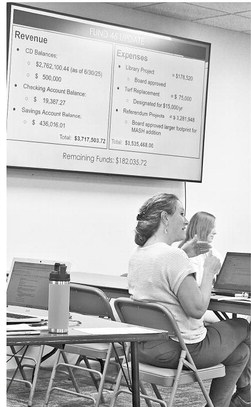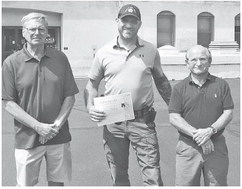Committee eyes county forestry finances
Attempts to put additional restrictions on forest department revenues and potential expenditures met with opposition at the February 27 forestry and recreation committee meeting.
An attempt to lower the cap on the county’s forestry land acquisition account from $500,000 to $250,000 failed gaining just two votes from committee chairman Scott Mildbrand and member Rollie Thums.
Under the state forest law, a portion of the proceeds from every timber sale goes into a county fund to purchase additional land for the county forest. The county has a number of rules in place for what land would be considered with the property owners having to approach the county about wanting to sell the land. Any land sales would then have to be approved by the committee and the full county board and in recent years have included the condition of being able to tap into state Knowles-Nelson Stewardship See COUNTY on page 5 funds which reimburse half the purchase cost. Completed land purchases have been fairly rare.
While the fund is designated for forest land acquisition, the county board can vote to use it for other purposes at any time, explained finance director Larry Brandl. From an accounting standpoint it is treated as any other county reserves. The current cap on the account was approved in 2015.
Mildbrand called for the cap to be lowered because he disagreed about the need for it to be earmarked for land acquisition and felt that having a large account balance made it much more likely the county would agree to purchase land in the future.
A second resolution aimed at more closely defining forest revenues also met with some resistance and was ultimately tabled until after a new forest administrator is hired.
This resolution is identical to one previously introduced by Mildbrand and would represent a shift in accounting for funds generated from the county forest. Under the current system, the funds generated from logging sales are held in forestry accounts and transferred over into the general fund each year minus the budget expenses of the forestry department.
Mildbrand proposed having all the money go into the general fund and the forestry department only operate with its budget and have to go through the same process as any other department in requesting funds through the finance committee and county board for additional items.
Committee member Gary Beadles said he saw no reason to make the change, noting the committee approved a budget and follows the budget each year.
The difference between what was proposed and what occurs now is largely reflective of the philosophy of how the funds should enter the county. The forestry department is fairly unique among government departments in that it produces income in excess of its operating revenues each year.
The county budgets for the operations of the department and receives a state grant each year to cover half the cost of the administrator position. The other staff in the office as well as equipment, vehicle and long term improvements are approved as part of the annual budget process. As with most departments, the forestry department has non lapsing funds where it retains money for future or ongoing projects.
One of the sticking points is regarding how forest revenues come into the county. Thums said he felt it should go into the general fund and then come back out after forestry goes through the request process with the county board.
“It does go into the general fund,” Brandl said. He noted there are a number of reserve accounts such as the dam maintenance and vehicle replacement where money is budgeted each year to help cover those longterm costs.
“This is not supposed to take any money away from the forestry department,” Mildbrand said of the proposal. “I want to make the forest department follow a budget like all other departments do,” he said.
“We already have a budget,” Beadles said. Mildbrand gave the example of the Chelsea Lake Dam, and said he felt they went with the more expensive option to build the dam because the money was there for it when he felt they could have gone with a less expensive option. Committee member Myron Brooks noted they chose to make the investment to build a better dam that would last longer before it needed major work.
Assistant forest administrator Alex Solawetz said he was uncomfortable with the committee making a change to the departments budgeting and financial set-up while the administrator position is vacant and asked that they table it until a new administrator has been hired and can give input.
Committee members agreed and tabled it until a new administrator is hired.
In other business, committee members:
Approved the closeout of two forest timber sales to Smola Enterprises. The first sale, #708 had significant under run in the estimate of the amount of oak to be harvested in the stand. This impacted the overall price the county received for the stand. Brooks questioned if it was a matter that the oak logs were punky and rotten and not suitable for saw logs. However, Solawetz said the amount of pulp oak logs was also over estimated. He said he would be looking into it further to find out why it was so far off from the estimates. Committee members also approved closing out sale 711 which was a small, 6-acre sale.
Approved going out to bid for the gravel for forest roads with the exception for a small amount for Trout Ave. as they research if it is a town road section. Mildbrand raised questions about the gates on forest roads and if the county was improving the roads there, why they would not be open for recreational users in the forest. Beadles agreed, noting that they should at least be open during the fall for bird hunters to access. Solawetz said he saw no problem with opening the gates in the fall. Committee member Myron Brooks said it should be up to the administrator to decide which roads should remain gated. A major concern is with people taking pickup trucks and other vehicles into the woods and tearing up the roads so that they require repairs before crews can use them to access logging stands. One of the reasons the county has had success in getting bidders for timber sales is due to the quality of the forest roads which allows better trucking access reducing the amount of skidding that needs to take place. “It makes a lot of difference on sales definitely,” Thums said.
Approved allowing Solawetz to get quotes for herbicide spraying on the recently planted pine plantations. The county planted 54 acres of pine seedlings in recent years and the spraying is done in late summer or early fall to reduce the competition from other plants so that the pine trees can take hold. The cost should be about $8,000 for both sites and Solawetz said it could be done with a drone to prevent damage to the young trees. He said this would likely need to occur an additional time after this at which point the trees should be tall enough to prevent competition.



